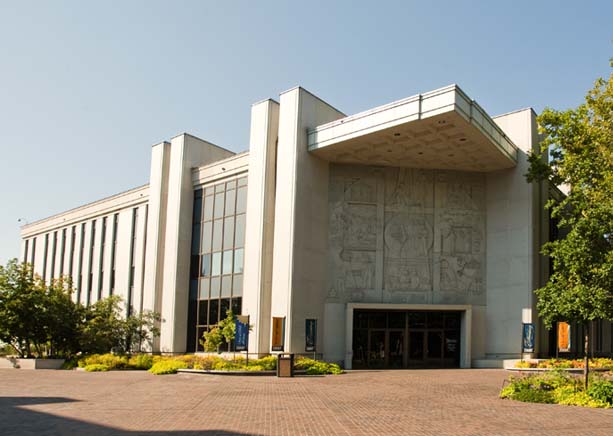 The authenticity of the Book of Mormon has been repeatedly assailed by critics of the LDS Church on the grounds that is lacks any confirmatory archaeological evidence that supports its claimed historicity as an ancient record. Countless books, articles, DVDs and internet websites have ceaselessly repeated the following cacophonous refrain:
The authenticity of the Book of Mormon has been repeatedly assailed by critics of the LDS Church on the grounds that is lacks any confirmatory archaeological evidence that supports its claimed historicity as an ancient record. Countless books, articles, DVDs and internet websites have ceaselessly repeated the following cacophonous refrain:
There is not a single piece of archaeological evidence that confirms the ancient authenticity of the Book of Mormon.
Sectarian critics of Mormonism usually throw in the following addendum to the aforementioned claim:
There is not a single piece of archaeological evidence that confirms the ancient authenticity of the Book of Mormon. The Bible, on the other hand, has been repeatedly proven by archaeological evidence. Because the Bible has been proven archaeologically, we can accept it as the word of God. Because the Book of Mormon has no archaeological evidence, we should reject it as scripture that can be relied on as a reliable source of God’s truth.
Joel Kramer of Living Hope Ministries has created a popular anti-Mormon DVD that makes this claim titled The Bible vs. The Book of Mormon. In it, Kramer attempts to validate the authenticity of the Bible on archaeological grounds, whilst simultaneously attempting to disprove the Book of Mormon on archaeological grounds. Because, according to Kramer, the Bible has been verified archaeologically we can turn to it as the infallible word of God, unlike the Book of Mormon. The same line of argumentation is also brought up by the producers of the 2007 video Jesus Christ vs. Joseph Smith. Many additional examples could be multiplied, but the above should be enough to convey the general argument of sectarian critics.
Besides the highly debatable claim that the Book of Mormon has no archaeological evidence to support its authenticity,[1] the sectarian reasoning that the Bible can be accepted as the word of God because of archaeological verification is highly suspect. In two reviews of Kramer’s DVD, David Bokovoy and Brant Gardner repeatedly demonstrate the fallacious reasoning behind this critical claim.[2] And it is not only the Latter-day Saints who are aware of this fallacy. Alfred Hoerth and John McRay, two non-Mormon biblical scholars, for example, have urged caution amongst believers of the Bible who try and use archaeology to prove biblical theology.[3] As William J. Hamblin effectively summarized:
Even if every historical event in the Bible were to be archaeologically verified, it still would not prove that God exists or that Jesus is the Christ any more than the discovery of archaeological sites mentioned by Homer in the Iliad has proven that Zeus is the King of Heaven.[4]
Unfortunately, this is compelling point of Hamblin’s is routinely overlooked or ignored by sectarian critics.
Furthermore, it has recently occurred to me that this argument used by sectarians is severely undermined by a wonderful book of Latter-day Saint scripture entitled the Doctrine and Covenants. Permit me, if you will, a few moments to explain how, following the logic of sectarian critics of Mormonism, archaeology proves beyond any doubt that the Book of Mormon is an ancient record and the word of God.
The D&C contains several references to the authenticity of the Book of Mormon. Take, for instance, this declaration of the Lord in D&C 17:6:
And he [Joseph Smith] has translated the book [the Book of Mormon], even that part which I have commanded him, and as your Lord and your God liveth it is true.
Consider also D&C 42:12, which reads:
And again, the elders, priests and teachers of this church shall teach the principles of my gospel, which are in the Bible and the Book of Mormon, in the which is the fulness of the gospel.
And finally, here is D&C 1:29:
And after having received the record of the Nephites, yea, even my servant Joseph Smith, Jun., might have power to translate through the mercy of God, by the power of God, the Book of Mormon.
Here are only three examples of many throughout the D&C that affirm the divine authenticity of the Book of Mormon. The Latter-day Saints believe these declarations to be the will and word of the Lord. They accept on faith the theological claims made in the D&C regarding the authenticity of the Book of Mormon.
One may be wondering how this archaeologically proves that the Book of Mormon is ancient scripture and the word of God. It is simple, really. The Doctrine and Covenants has been overwhelming verified by archaeological evidence as an authentic text of the 19th century. Consider the following:
- The D&C mentions American place-names such as Harmony, New York City, Albany, Boston, Kirtland, Independence, Nauvoo, Fayette, Manchester, Hiram, Salem, Far West, Ramus, and Salt Lake City. Every single one of these locations has been indisputably verified archaeologically. You can locate any of these places on a map of the United States.
- The D&C details the geography of states such as New York, Missouri, Ohio, Illinois, and Massachusetts. Other portions of the D&C were received in Nebraska and Utah. Each of these states is still in existence today, and there is no question from the archaeological evidence that they existed in the 19th century. Thus, altogether, the geography of the D&C is 100% archaeologically verified. Contrast this with the Bible, which still has ambiguous geography that is open for debate amongst scholars and archaeologists. Some of the geography of the Bible, i.e. the Garden of Eden, is doubted by many scholars to have even existed, and is increasingly being deemed mythological. Not so with any of the geography of the D&C.
- The D&C names individuals such as Joseph Smith, Oliver Cowdery, Martin Harris, David Whitmer, Emma Smith, Orson Pratt, Orson Hyde, John Taylor, Brigham Young, David Patten, Joseph Smith, Sr., and countless others. Every single individual mentioned in the D&C has been proven archaeologically to have actually existed in the 19th century. We have their journals, their personal belongings, photographs, eyewitness descriptions, census records, birth-date and death-date records, living descendants that can be verified through DNA evidence, etc., all confirming without any question that these were real people. And unlike many of the biblical prophets, there is no debate amongst scholars whether Joseph Smith was a real person or merely an idealized personification of the archetypal prophet. Unlike the biblical figures Adam, Enoch, Noah, Abraham, and Moses, among others, scholars are not debating whether Joseph Smith or Brigham Young or John Taylor actually existed. There is no debate amongst scholars whether Brigham Young actually led thousands of Mormons across the American frontier. Wish that were so with Moses and the reported Exodus of the Israelites out of Egypt, as the historicity of the Exodus story is hotly contested by scholars.
- Unlike any of the biblical books, we have the original autographs for many of the revelations contained in the D&C. And, we have multiple extant copies of manuscripts of the D&C that date to years, or even months, after the original, unlike the extant copies of the biblical texts which date decades or even centuries after the autographs were written.
- Today, in Salt Lake City, artifacts belonging to the people mentioned in the D&C and manuscripts of the D&C can be found in the Church History Library and the Museum of Church History and Art. What’s more, we know these artifacts actually belonged to individuals named in the D&C. That includes books, clothing, utensils, tools, and other trinkets. Thanks to names inscribed on the artifact (how many examples of handwriting do we have from any biblical figure?) and other evidence we can be absolutely positive than certain artifacts once belonged to certain individuals mentioned in the D&C.
By now the point should be obvious. The Doctrine and Covenants has been overwhelming proven archaeologically. The events of the past that it reports, and the people, places, and things is describes have been proven archaeologically. If we follow the argument of sectarian critics, then the theological claims of the D&C have also been proven because its historicity has been proven. And because its theological claims have been proven, the Book of Mormon therefore has been proven to be ancient scripture since one of the theological claims of the D&C is that the Book of Mormon is authentic.
If the critics are going to be consistent, and not trap themselves in a double standard, then they must concede that the Book of Mormon is authentic. The D&C has been proven archaeologically. The D&C testifies that the Book of Mormon is authentic. Ergo, the Book of Mormon is authentic.
Now, of course, I am not seriously arguing that the question of the Book of Mormon’s historicity is settled because the D&C has been proven archaeologically. That debate is still very much open to differing opinions and arguments. Nor am I seriously arguing that the theological claims of the Doctrine and Covenants have been proven true because of archaeology. (Likewise, I will mention in anticipation to possible future objections by any Evangelical critics that I am not attempting to attack the Bible. It is not my goal in this post to try and disprove the Bible.) My point is to show the double standard used by sectarian critics. If we follow the logic of the critics, viz., archaeology proves the theology of the Bible, then it follows that archaeology also proves the theology of the Doctrine and Covenants, which in turn proves the Book of Mormon is scripture.
Covenants, which in turn proves the Book of Mormon is scripture.
Therefore, the sectarian argument that archaeological verification = theological verification needs to be put to rest.
[Kerry Shirts, the lovable Backyard Professor, has produced a video putting forth an identical argument that I have put forth here. See his YouTube video "The Power of Archaeology for the D&C", online here.]
Notes:
[1]: For starters, see here, here, here, here, here, and here. Many more samples could be provided; on such, see here.
[2]: David Bokovoy, “The Bible vs. The Book of Mormon: Still Loosing the Battle,” FARMS Review 18/1 (2006), 3-19, online here; Brant Gardner, “Behind the Mask, Behind the Curtain: Uncovering the Illusion,” FARMS Review 17/2 (2005), 145-195, online here. See also the FAIR produced video “The Bible vs. The Book of Mormon: A Close Examination”, online here.
[3]: Alfred Hoerth and John McRay, Bible Archaeology: An Exploration of the History and Culture of Early Civilizations (Grand Rapids: Baker Books, 2005), 11-12.
[4]: William J. Hamblin, “Basic Methodological Problems with the Anti-Mormon Approach to the Geography and Archaeology of the Book of Mormon,” Journal of Book of Mormon Studies 2/1 (Spring 1993), 186. The entire article, which can be accessed online here, is worth reading with special attention.
Continue reading at the original source →



